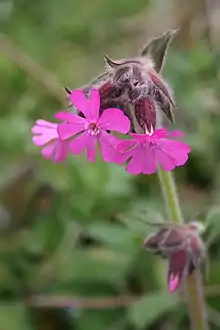Silene
Silene is a genus of flowering plants in the family Caryophyllaceae. Containing nearly 900 species,[1] it is the largest genus in the family.[2] Common names include campion and catchfly. Many Silene species are widely distributed, particularly in the northern hemisphere.[2]
| Silene | |
|---|---|
 | |
| Silene dioica (red campion) | |
| Scientific classification | |
| Kingdom: | Plantae |
| Clade: | Tracheophytes |
| Clade: | Angiosperms |
| Clade: | Eudicots |
| Order: | Caryophyllales |
| Family: | Caryophyllaceae |
| Genus: | Silene L. |
| Species | |
| Synonyms[1] | |
|
List
| |
Scientific history
Members of this genus have been the subject of research by preeminent plant ecologists, evolutionary biologists, and geneticists, including Charles Darwin, Gregor Mendel, Carl Correns, Herbert G. Baker, and Janis Antonovics. Many Silene species continue to be widely used to study systems, particularly in the fields of ecology and evolutionary biology.[3] The genus has been used as a model for understanding the genetics of sex determination for over a century. Silene species commonly contain a mixture of hermaphroditic and female (or male-sterile) individuals (gynodioecy), and early studies by Correns showed that male sterility could be maternally inherited,[4][5] an example of what is now known as cytoplasmic male sterility. Two independent groups of species in Silene have evolved separate male and female sexes (dioecy) with chromosomal sex determination that is analogous to the system found in humans and other mammals.[6][7]
Silene flowers are frequently visited by flies, such as Rhingia campestris.[8] Silene species have also been used to study speciation, host-pathogen interactions, biological species invasions, adaptation to heavy-metal-contaminated soils, metapopulation genetics, and organelle genome evolution.[3] Notably, some members of the genus Silene hold the distinction of harboring the largest mitochondrial genomes ever identified.[9]
Etymology
Silene is the feminine form of Silenus, an Ancient Greek woodland deity who was a companion and tutor to the wine god Dionysus.[10]
Taxonomy
Silene was originally described by Linnaeus.[1] Divisions of the genus into subgenera or sections before 2003 do not seem to be well-supported by molecular evidence.[2]
The genus Lychnis is closely related to (and sometimes included in) Silene.[11][12] When treated as a distinct genus, it can often be differentiated by the number of flower styles (five in Lychnis' and three in Silene), the number of teeth of the seed capsule (five in Lychnis' and six in Silene), and by the sticky stems of Lychnis.
Sexual systems
Sexual systems vary across species. Most Silene species are hermaphroditic representing 58.2% of Silene species, 14.3% are dioecious, 13.3% gynodioecious, and 12.2% are both gynodioecious and gynomonoecious. Trioecy, andromonoecy, and gynomonoecy have also been reported but are extremely rare.[13]
Species
Ecology
Lychnis is also the common name of Hadena bicruris, a species of noctuid moth. The larva of this moth feeds on Silene (formerly Lychnis) species, as do some other Lepidoptera including cabbage moths (recorded on Silene chalcedonica), grey chi and case-bearers of the genus Coleophora including C. albella (feeds exclusively on Silene flos-cuculi).
Uses
Many species of Silene are in cultivation for perennial gardens.[14] Some have gained the Royal Horticultural Society's Award of Garden Merit, including Silene flos-jovis and Silene schafta.[15]
Silene undulata (syn. S. capensis) is known as iindlela zimhlophe ("white paths") by the Xhosa of South Africa. A Xhosa diviner identifies and collects the plant from the wild. The roots are ground, mixed with water, and beaten to a froth, which is consumed by novice diviners during the full moon to influence their dreams. They also take it to prepare for various rituals. The root has such a strong, musky essence that the diviners who consume it exude the scent in their sweat.[16]
Silene vulgaris, or bladder campion, is eaten in some Mediterranean countries. Young leaves may be eaten raw, and mature leaves are boiled, fried, stewed or mixed into dishes such as risotto.
Fossil record
Fossil †Silene microsperma seeds from the Chattian stage of the Oligocene have been found in the Oberleichtersbach Formation in the Rhön Mountains of central Germany.[17]
References
- "Silene L." Plants of the World Online. Royal Botanic Gardens, Kew. Retrieved 4 August 2020.
- "36. Silene Linnaeus". Flora of North America.
- Bernasconi et al. 2009. Silene as a model system in ecology and evolution. Heredity. 103:5-14. PMID 19367316
- Correns C. 1906. Die vererbung der Geshlechstsformen bei den gynodiocischen Pflanzen. Ber. Dtsch Bot. Ges. 24: 459–474.
- Correns C. 1908. Die rolle der mannlichen Keimzellen bei der Geschlechtsbestimmung der gynodioecishen Pflanzen. Ber. Dtsch Bot. Ges. 26A: 626–701.
- Evolution of Sex Chromosomes: The Case of the White Campion. PLoS Biol 3(1): e28. doi:10.1371/journal.pbio.0030028
- Mrackova M. et al. 2008. Independent origin of sex chromosomes in two species of the genus Silene. 179(2): 1129–1133. PMID 18558658
- Van Der Kooi, C. J.; Pen, I.; Staal, M.; Stavenga, D. G.; Elzenga, J. T. M. (2015). "Competition for pollinators and intra-communal spectral dissimilarity of flowers". Plant Biology. 18 (1): 56–62. doi:10.1111/plb.12328. PMID 25754608.
- Sloan DB et al. 2012. Rapid Evolution of Multichromosomal Genomes in Flowering Plant Mitochondria with Exceptionally High Mutation Rates. PLoS Biol. 10: e1001241. doi:10.1371/journal.pbio.1001241
- Quattrocchi, U. CRC World Dictionary of Plant Names. 1999. 4: 2482. ISBN 0-8493-2678-8
- Europaea: Lychnis
- Flora of China: Lychnis
- Casimiro-Soriguer, Inés; Buide, Maria L.; Narbona, Eduardo (2015-01-01). "Diversity of sexual systems within different lineages of the genus Silene". AoB Plants. 7 (plv037): plv037. doi:10.1093/aobpla/plv037. ISSN 2041-2851. PMC 4433491. PMID 25862920.
- "Silene". Better Homes & Gardens. Retrieved 4 August 2020.
- "Results > Search for AGM plants / RHS Gardening". apps.rhs.org.uk. Retrieved 4 August 2020.
- Hirst, M. (2005). Dreams and medicines: The perspective of Xhosa diviners and novices in the Eastern Cape, South Africa. Indo-Pacific Journal of Phenomenology 5(2) 1-22.
- The floral change in the tertiary of the Rhön mountains (Germany) by Dieter Hans Mai - Acta Paleobotanica 47(1): 135-143, 2007.